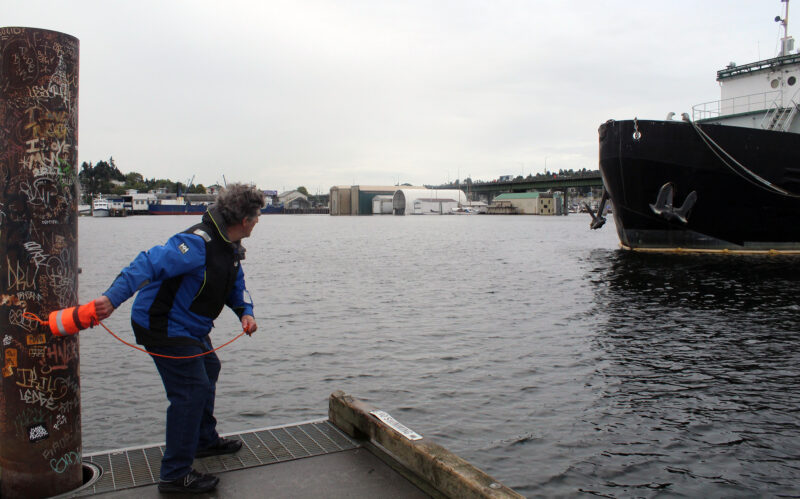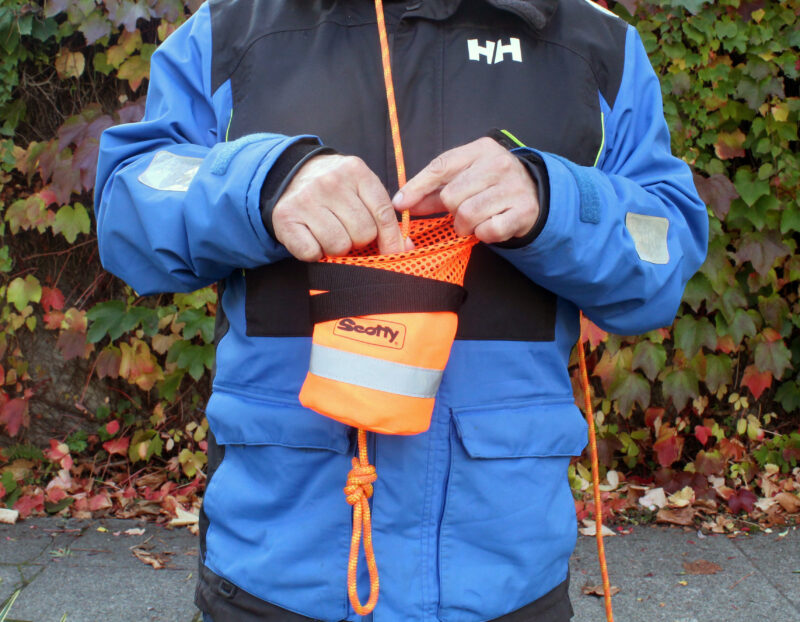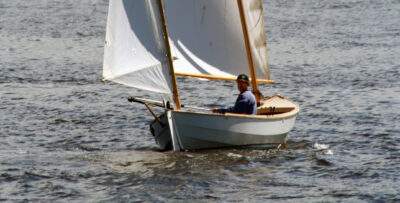When I stepped aboard a friend’s little motor cruiser, the first bit of kit I noticed was a rescue throw bag hanging at the ready from the wheelhouse overhead. It got me thinking about the usefulness of a dedicated rescue line and the fact that I didn’t have one. I’d assumed that with all the lines I have on board, including my heaving line with a monkey’s fist, whichever one I could lay my hands on could be used as a throw rope in an emergency. But what I might have handy might not float or be coiled in a manner that I could deploy quickly and throw accurately.
 Christopher Cunningham
Christopher CunninghamThe floating line contained in the bag has a 47′ reach. The bag, with the line packed into it, weighs less than 14 oz.
So, I recently bought a Scotty Rescue Throw Bag to fill the gap in my safety gear. Its bright orange bag is 8″ long, 4 1⁄2″ in diameter, and it has a disc of 3⁄4″-thick closed-cell foam for flotation on the inside and a band of retroreflective material on the outside for enhanced visibility in the beam of a flashlight. The top of the bag is made of mesh, making the bag self-draining. A cord and spring-toggle tighten the opening around the loop at the end of the line stuffed in the bag so there’s no rummaging around to find the loop to hold onto when throwing the bag. The line is a 50′ length of 9⁄32″ floating polypropylene kernmantle rope. Each end of it has a bight tied with a figure-eight knot. (The knots take up a bit of the line, so its working length is 47′.) The rope is “flaked” into the bag so it will pay out without getting hung up. The bag and line weigh just under 14 oz.
To throw the bag, you open its mouth, hang onto the loop with your non-throwing hand, and pull out about 10’ of line. Next, grab the bag with your other hand and throw it underhand, overhand, or sidearm—whichever you prefer. I practice mostly underhand and some overhand. The aim is to get the bag to land beyond the rescuee with the line draped over them. The 47′ length of the line is more than enough. My best throws, on land where I could measure them, were at 45′. More often the bag landed at a distance of 35′ to 40′. Throwing with accuracy comes with practice.
 Rachel Hynd
Rachel HyndAn underhand throw begins with holding the tail end of the line with one hand and swinging the bag forward with the other.
 Rachel Hynd
Rachel HyndIf the line has been properly packed, it slips out of the bag without tangles.
 Rachel Hynd
Rachel HyndA good throw will land the bag at nearly the full extension of the line.
There are different methods for stuffing the line back into the bag, and all involve pushing just a few inches of line in at a time. It may seem messy, but it ensures the line will feed out without getting hung up when the bag is thrown. You can hold the bag open with pinkies and ring fingers on both hands and feed the line in, pinching it between thumb and index finger, alternating hands as you push line in. I prefer holding the bag with the ring and pinkie fingers of my right hand and guiding the line with a bit of friction with a stationary right thumb and index finger. The thumb and forefinger of the left hand pull the line in a few inches with each pull. Having the line draped over your shoulder makes either method easier.
 Rachel Hynd
Rachel HyndThe line has to be put back into the bag by pushing it in a few inches at a time. Hold the bag open with the ring and pinkie fingers and push in the line, pinched between the thumb and index finger, first one hand…
 Rachel Hynd
Rachel Hynd…then the other.
Restuffing the bag takes a few minutes and isn’t necessary or practical if you miss connecting with the rescue on the first throw. The coiling methods in this issue’s Technique article are much quicker and ensure the rope doesn’t get tangled when the coil is thrown along with the empty rescue bag.
Because I do a lot of boating alone, much of the safety gear I carry on board was acquired with keeping myself safe in mind. The Scotty Rescue Throw Bag will make me better equipped to help others.![]()
Christopher Cunningham is the editor of Small Boats.
The 793 Rescue Throw Bag is made by Scotty and available from many outdoor and boating retailers and online vendors. The price is around $27.
Is there a product that might be useful for boatbuilding, cruising, or shore-side camping that you’d like us to review? Please email your suggestions.












There are a lot of nice features with that bag, high-viz color for one and the foam disc another. And the concept of a throw bag is surprisingly effective, as I found out in a Walmart one day. Before I committed to a first time purchase, I wondered if the line would come out as easily as advertised…Boy did it! That bag sailed down the sporting goods aisle like an Olympian had thrown it, much to Skipper’s embarrassment.
We bought the bag, maybe it’s time to test it out again, as I’m not sure how years of being packed and not deployed will have affected its functionality.
Cheers!
Skipper and Clark
There are a number of brands of these that are available; check the whitewater community. I have one that was made for ice work, long and skinny spot on accurate. My old whitewater one is a pretty loose back and very flexible rope; not a DIY but very easy to make or adapt. The loose bags are easier and faster to restuff.
This safety tool is a legal requirement in small boats in Canada.
This gear, unlike a coiled line, seems like it could be easily thrown by an inexperienced crew with just a little bit of teaching.